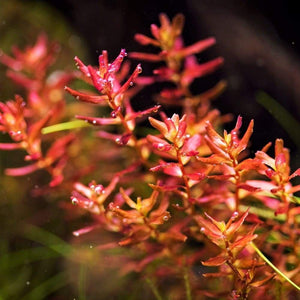Your Cart is Empty
Free shipping on all orders over $99!*(Click here to see exclusions)


This aquatic plant is a mini version of Rotala Macrandra.
It is an outstanding, beautiful aquarium plant that requires great care and attention. It requires high lighting to develop its beautiful red color. A constant inflow of CO2 and soft water are also vital to ensure reasonable growth. This plant achieves its most beautiful state when in groups, however, do not plant individual tissues too close because this will prevent light from reaching the lower leaves. To ensure a strong coloration for this plant there must be sufficient micro-nutrients in the water.
| Name | Rotala macrandra 'Mini Butterfly' |
| Structure | Stem |
| Difficulty | Advanced |
| Light Demand | High Light |
| CO2 Demand | CO2 Required |
| Growth Rate | Moderate Growth |
| Placement | Background |
| Height (in) | 4-12+ |
| Color | Red |
Tissue culture plants are grown in-vitro (literally: in the glass) in a nutrient-rich synthetic growing medium, either liquid or gel, without the presence of any other lifeforms. This guarantees a pest and disease-free specimen, while also providing accuracy throughout the trade.
Loose cuttings are harvested from our aquariums at Aqua Lab. While we try our best to remove snails, we can't guarantee that these plants will be pest or disease-free. It's common for tiny snails or microscopic snail eggs to hitchhike on plants that come from an established aquarium. A single portion of cuttings can vary and depends on the species, but generally, it's about a handful. For stem plants, this is typically a bunch of several stems that are approx. 6"+ in length. If the stems do not have roots, simply plant them and roots will sprout in time. For crown plants like Crypts, it will be a single established plant with roots. For rhizome plants like Anubias, Java Fern, and Bucephelandra, a portion is usually one segment of rhizome with several leaves and roots coming off of it. Please keep in mind that plant and portion sizes can vary as our plants grow and propagate.
Tissue culture plants should be removed from the cup as soon as possible. All plants grow on some sort of synthetic growing medium, ranging anywhere from liquid to jelly to firm gel. This should be removed and rinsed off. Gently massage the roots between your fingers until the gel dissolves away. Most plants can be broken up into smaller pieces and spread out in your aquarium. Smaller pieces are easier to plant.